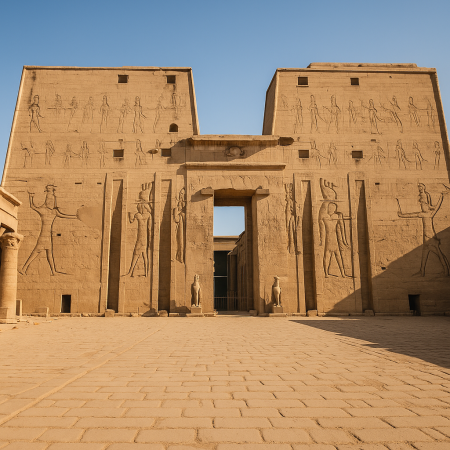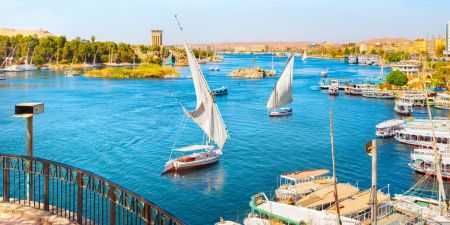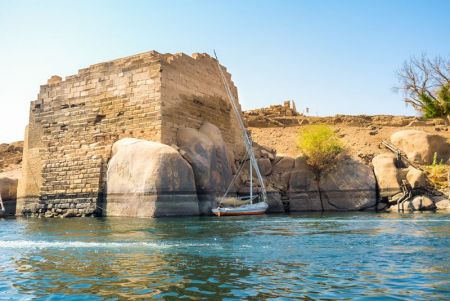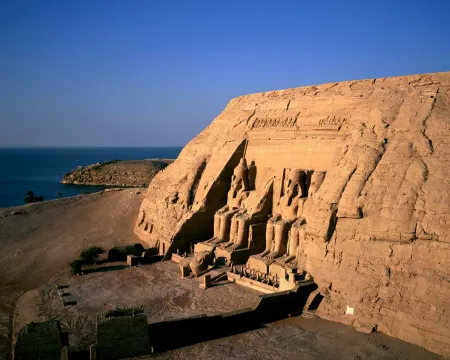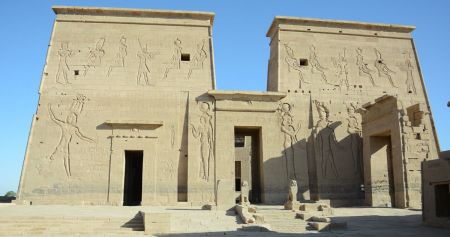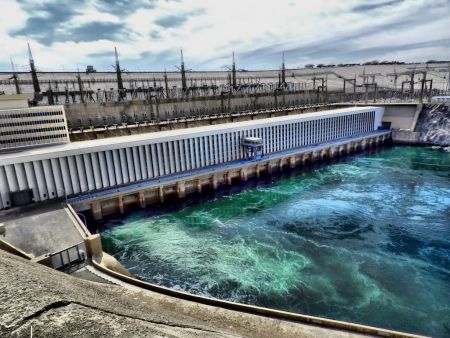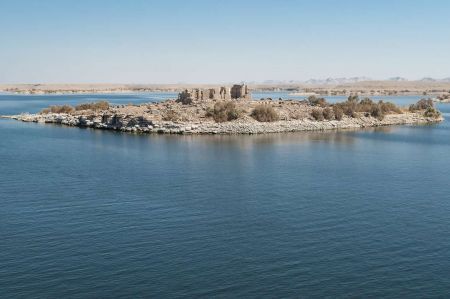Kom Ombo Temple: The Twin Sanctuary of the Nile’s Crocodile and Falcon Gods

Perched majestically on a bend of the Nile between Aswan and Edfu, Kom Ombo temple is a unique architectural wonder dedicated to two powerful ancient Egyptian gods: Sobek, the crocodile-headed god of fertility and protector of the Nile, and Horus the Elder (Haroeris), the falcon-headed sky god. This rare double temple, with its symmetrical design and dual sanctuaries, stands as a remarkable symbol of balance, divine duality, and religious harmony in ancient Egypt.
Built during the Ptolemaic dynasty (circa 180–47 BCE) and expanded by later Roman emperors, Kom Ombo Temple served both religious and political purposes. The site offered protection to river travelers and reinforced Greco-Egyptian religious unity during a period of foreign rule. Its elaborate reliefs, detailed astronomical carvings, and medical instruments etched in stone have made it one of Egypt’s most historically significant and visually striking temples.
Surrounded by desert and flanked by palm trees and the shimmering Nile, Kom Ombo is more than a temple—it's a mirror into ancient theology, medicine, and myth, and a popular stop for Nile cruises that connect Egypt’s southern treasures.
History and Construction of Kom Ombo Temple – A Fusion of Power and Faith
Origins Under the Ptolemies
The core of Kom Ombo Temple was built by Ptolemy VI Philometor in the 2nd century BCE and expanded by his successors, including Ptolemy XIII and Roman emperors like Augustus. The temple was constructed atop earlier foundations, possibly from the New Kingdom, which confirms the site’s long-standing religious importance.
Unlike most Egyptian temples, Kom Ombo Temple was designed to honor two gods equally—each side of the temple is a mirror image of the other, with identical halls, sanctuaries, and entrances. The northern half is dedicated to Horus the Elder, and the southern half to Sobek. This architectural symmetry symbolized harmony between divine powers.
Roman Contributions and Architectural Legacy
The Romans added decorative reliefs, courtyards, and inscriptions, enriching the site with imperial iconography. Their contributions blended smoothly with traditional Egyptian design, preserving the spiritual essence of the temple while asserting Roman presence. A notable Roman-era Nilometer and lion-headed gargoyles used for water drainage remain visible on site.
The Deities of Kom Ombo – Sobek and Horus the Elder
Sobek – God of the Nile and Fertility
Sobek, depicted with the head of a crocodile, was worshipped as a god of strength, fertility, and protection. He represented the might and danger of the Nile—essential for life but capable of destruction. Crocodiles were kept in sacred pools near the temple, mummified after death, and honored with burial rituals. Sobek’s cult flourished in Kom Ombo due to the region’s proximity to crocodile-infested waters.
Horus the Elder – God of Kingship and the Sky
Horus the Elder (Haroeris), distinct from Horus the Younger (son of Osiris), symbolized the sky, divine order, and royal protection. His falcon-headed form embodied vigilance and strength. The temple’s northern wing honors his victories over evil and his role as a protector of kingship, reinforcing the divine legitimacy of the Ptolemaic rulers.
Architectural Layout – A Perfectly Balanced Dual Temple
Symmetry and Separation
Kom Ombo’s layout is truly unique: two entrances, two hypostyle halls, two sanctuaries, and twin sets of rooms—all symmetrical yet distinct. This design allowed priests to perform rituals for Sobek and Horus simultaneously without crossing into the other’s domain. Reliefs on the walls often depict both gods being worshipped side by side.
Hypostyle Halls and Reliefs
The hypostyle halls are filled with lotus-capped columns and intricately carved walls depicting offerings, purification rituals, and scenes of healing. Reliefs include Ptolemaic rulers presenting gifts to the gods, emphasizing their divine right to rule and religious devotion.
Birth House and Chapel of Hathor
A mammisi (birth house) adjacent to the main temple celebrates the divine birth of Horus, echoing similar structures in Dendera and Edfu. Nearby is the Chapel of Hathor, where visitors can view crocodile mummies discovered in the area—fascinating evidence of Sobek’s cult and the temple’s ritual practices.
Book complete itineraries and guided experiences with our Egypt Travel Packages
Notable Inscriptions and Carvings – Ancient Knowledge in Stone
Medical Reliefs and Surgical Instruments
One of Kom Ombo’s most intriguing features is a wall relief displaying what appears to be a set of ancient surgical tools—scalpels, forceps, suction cups, and scissors. This has led scholars to believe the temple may have been associated with healing or medical training. The detail suggests a sophisticated understanding of anatomy and medicine in Ptolemaic Egypt.
Calendar and Astronomical Carvings
Another section includes astronomical ceilings and calendars, used to regulate religious festivals and agricultural cycles. These inscriptions not only reflect spiritual beliefs but also practical concerns about timekeeping and celestial observation.
The Crocodile Museum – Guardians of the Sacred Waters
Adjacent to the temple, the Kom Ombo Crocodile Museum showcases dozens of mummified crocodiles, some preserved with remarkable detail. These animals were sacred to Sobek and often buried ceremoniously. The museum displays coffins, amulets, and votive offerings used in the crocodile cult, offering visitors a direct connection to one of Egypt’s most fascinating religious practices.
Religious Significance and Cultural Symbolism
Duality and Balance in Worship
Kom Ombo reflects a theological philosophy of balance between opposing forces—life and death, creation and destruction, chaos and order. Sobek and Horus embody this duality, and their shared temple reveals how ancient Egyptians embraced paradox within their religious worldview.
Political and Religious Propaganda
By honoring both gods equally, the Ptolemies presented themselves as unifiers of the divine realm and restorers of Ma’at (cosmic order). This helped legitimize their foreign rule over Egypt and win loyalty from native priesthoods.
Visiting Kom Ombo Temple – What to Expect
Location and Accessibility
Kom Ombo is located about 45 km north of Aswan, and is a popular stop on Nile cruise itineraries. The temple lies directly on the riverbank, offering breathtaking views and easy access by boat or road.
Best Time to Visit
Morning or late afternoon provides the best light for photography and avoids the midday heat. Sunset visits are especially magical, with golden light bathing the temple’s reliefs and casting long shadows across its colonnades.
Tickets and Tips
Entrance fees are affordable, and guided tours are highly recommended to fully appreciate the temple’s intricate symbolism. Bring water, a hat, and comfortable shoes—Kom Ombo may be compact, but there’s plenty to explore.
Searchable FAQs about Kom Ombo Temple
What makes Kom Ombo Temple unique?
It’s the only temple in Egypt designed for dual worship, honoring both Sobek and Horus with two identical halves and sanctuaries.
Who built Kom Ombo Temple?
The temple was primarily built by Ptolemy VI in the 2nd century BCE and expanded by later Ptolemies and Roman emperors.
Why were crocodiles mummified at Kom Ombo?
Crocodiles were sacred to Sobek. They were kept near the temple and buried ceremonially as part of religious rites.
What are the tools depicted on Kom Ombo’s medical reliefs?
The carvings show scalpels, forceps, and other instruments, suggesting the temple may have been linked to healing and medicine.
Is Kom Ombo Temple part of a Nile cruise?
Yes, most Nile cruises between Luxor and Aswan include Kom Ombo as a scheduled stop, often paired with Edfu Temple.
Conclusion – Kom Ombo: Harmony of Gods, Culture, and Power
The Temple of Kom Ombo is not just an architectural gem—it's a profound expression of ancient Egypt’s dualistic worldview. With its twin sanctuaries, crocodile mummies, healing symbols, and myth-laden walls, it bridges the divine and the earthly, the practical and the mystical. Whether you're sailing the Nile or diving into Egypt’s spiritual past, Kom Ombo is an essential chapter in the story of a civilization that revered both the falcon and the crocodile as equal forces of life.



